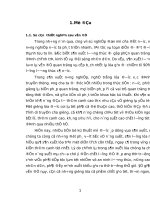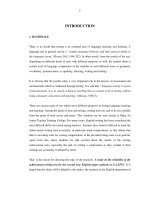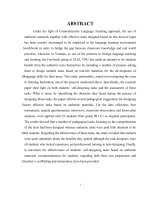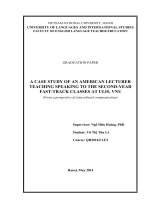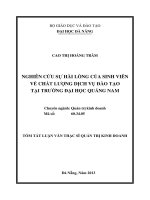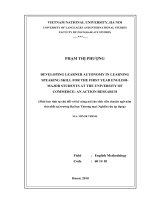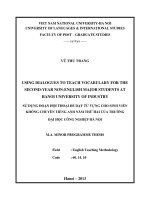ĐIỂN CỨU VỀ MỘT GIÁO VIÊN NGƯỜI MĨ DẠY KĨ NĂNG NÓI CHO SINH VIÊN CHẤT LƯỢNG CAO NĂM THỨ HAI TẠI TRƯỜNG ĐẠI HỌC NGOẠI NGỮ, ĐẠI HỌC QUỐC GIA HÀ NỘI
Bạn đang xem bản rút gọn của tài liệu. Xem và tải ngay bản đầy đủ của tài liệu tại đây (286.32 KB, 58 trang )
VIETNAM NATIONAL UNIVERSITY, HANOI
UNIVERSITY OF LANGUAGES AND INTERNATIONAL STUDIES
FACULTY OF ENGLISH LANGUAGE TEACHER EDUCATION
GRADUATION PAPER
A CASE STUDY OF AN AMERICAN LECTURER
TEACHING SPEAKING TO THE SECOND-YEAR
FAST-TRACK CLASSES AT ULIS, VNU
(From a perspective of intercultural communication)
Supervisor: Ngơ Hữu Hồng, PhD
Student: Vũ Thị Thu Lý
Course: QH2010.F1.E2
Hanoi, May 2014
ĐẠI HỌC QUỐC GIA HÀ NỘI
TRƯỜNG ĐẠI HỌC NGOẠI NGỮ
KHOA SƯ PHẠM TIẾNG ANH
KHÓA LUẬN TỐT NGHIỆP
ĐIỂN CỨU VỀ MỘT GIÁO VIÊN NGƯỜI MĨ DẠY KĨ NĂNG
NÓI CHO SINH VIÊN CHẤT LƯỢNG CAO NĂM THỨ HAI
TẠI TRƯỜNG ĐẠI HỌC NGOẠI NGỮ, ĐẠI HỌC QUỐC GIA
HÀ NỘI
Giáo viên hướng dẫn: Ngô Hữu Hồng
Sinh viên: Vũ Thị Thu Lý
Khóa: QH2010.F1.E2
Hà Nội - 2014
ACCEPTANCE
I hereby state that I: Vũ Thị Thu Lý, E2K44, being a candidate for the
degree of Bachelor of Arts (TEFL) accept the requirements of the College relating
to the retention and use of Bachelor’s Graduation Paper deposited in the library.
In terms of these conditions, I agree that the origin of my paper deposited in
the library should be accessible for the purposes of study and research, in
accordance with the normal conditions established by the librarian or the care,
loan or reproduction of the paper.
Signature
Vũ Thị Thu Lý
Date: May 5th 2014
ACKNOWLEDGEMENTS
On the completion of this work, I wish to express my deepest gratitude to
my supervisor, Dr. Ngơ Hữu Hồng, who gave me the benefit of his wisdom,
advice and patience, who made valuable suggestions and careful critical comments
that helped me to carry out this study.
Besides, I want to express my gratefulness to Ms X, who is the American
teacher participating enthusiastically in my research as the direct participants. I am
also indebted to 25 second- year students of Fast- track program for agreeing to
participate in my paper.
Finally, I want to express my love and gratitude to my beloved friends
and family for supporting me wholeheartedly.
i
ABSTRACT
As one of the first attempts to raise an awareness of Intercultural
communication, the paper aims at investigating the cultural problems, cultural
adaptation of a visiting American lecturer who is teaching English in Vietnam as
well as the attitudes of the students towards her behaviors. To fulfill this primary
aim, qualitative method with two research instruments including interviews and
observations were adopted. The participants of the study were an American lecturer
and 41 second-year students of Fast-Track Program. The most significant finding
of the research was that in spite of short-term living in Vietnam with a lot of culture
shocks, the visiting American lecturer was successful to adapt Vietnamese culture
and demonstrated high teacher credibility thanks to her strategies and the
globalization going on in Vietnam. The paper, therefore, would serve as a good
reference for both English language teachers and foreign language specialized
students who desire to have a closer look at this issue or to improve their
Intercultural sense.
ii
TABLE OF CONTENTS
ACKNOWLEDGEMENTS....................................................................................i
ABSTRACT............................................................................................................ii
CHAPTER 1: LITERATURE REVIEW..............................................................5
CHAPTER 2: METHODOLOGY.......................................................................13
2.5.1. Participants........................................................................................................19
2.5.2. Data collection...................................................................................................19
CHAPTER 3: THE STUDY.................................................................................23
2.
Findings from the observations.........................................................................39
REFERENCES.....................................................................................................44
APPENDIX 1: GUIDED QUESTIONS FOR INTERVIEW.............................48
iii
INTRODUCTION
The first part of the study discusses the rationale, the aims, the scope as well
as the significance of the study together with a brief overview of the research. The
two research questions, in particular, are clearly identified to work as the guidelines
for the whole paper.
I.
Rationale of the study
In today’s modern world, learning foreign languages becomes more and more
popular because of globalization, so it is common that people go abroad to other
countries for working and language teaching. Therefore, in the context of
intercultural communication, culture shock is believed to be unavoidable. For that
reason, a research on how a visiting teacher encounters culture shocks to adapt a
foreign culture would be beneficial to the researcher’s future career as an English
teacher.
There is no doubt that English becoming the international language for
communication leads to a rise in English speaking teacher recruitment in many
universities in Vietnam. However, it is a matter of fact that cultural barrier is one of
the biggest problems in communicating in general and teaching in particular.
Therefore, this study with the focus on the way an American lecturer encounters
culture shock and her adaptation to Vietnamese culture helps the researcher raise an
awareness of intercultural communication areas including American culture,
Vietnamese culture as well as human culture.
Furthermore, in the position as an undergraduate student at the Faculty of
English language teacher education, the researcher realizes that effective teaching
is one of the most important factors in the process of developing future career.
After four years observing and working with local as well as foreign teachers in the
context of intercultural communication, the researcher finds out that American
lecturers’ teaching is very effective, attractive and interesting. Therefore, it
motivates the researcher to involve their teaching in the thesis in order to make a
1
useful and practical impact on the profession of teaching after graduation. Through
the study, the researcher could create and develop personal career benefits as well
as gain pedagogical experience from the professional American lecturer.
All of these become the motivation that stimulates the researcher to conduct a
research on “A case study of an American lecturer teaching speaking to the secondyear fast- track classes at ULIS, VNU” from a perspective of Intercultural
communication.
II.
Aims of the study
This study aims at discovering the difficulties, attitudes as well as strategies of
an American lecturer when she comes to a foreign country namely Vietnam for
language teaching. Also, the study investigates the way how Vietnamese students
identify the cultural differences, their attitudes towards a foreign culture through
the teacher’s behaviors as well as how they are influenced by the foreign teacher.
III.
Research questions
In the implementation of this research, the researcher tries to answer these
following research questions:
1)
What cultural problems does she_ the visiting American lecturer_ encounter
when living and teaching in Vietnam?
2)
How well does she adapt herself in Vietnamese culture?
IV.
Significance of the study
As a future English teacher, the researcher realizes that a good teaching
method does not include only the teaching of four skills: listening, speaking,
reading and writing. Suffice it to say that it is necessary to achieve the Intercultural
sense in order to gain professional development from the American lecturer
through this kind of research. In other words, it could be beneficial for the
2
researcher’s future career by training the Intercultural sense thanks to the teaching
of the visiting lecturer.
Also, it is clearly seen that the current research into the area of English
speaking teaching from a perspective of Intercultural communication is highly
limited. Therefore, this study will partly help fill the gap in the literature.
Although the study is carried out as a small scale one, the researcher hopes
that its results could be a good source for both teachers and students who are
concerning about English teaching and intercultural communication.
V.
Scope of the study
Although there are many other lecturers in the English Department of ULIS,
VNU, the researcher choose Ms. X for several reasons. She is responsible for
teaching speaking to two second-year fast-track classes. Therefore, all the students
from class 12E1 and 12E15 and their American speaking teacher are included in
this study. The decision to focus on two cases of the visiting American lecturer and
her students was made based on the purpose of referencing their problems, attitudes
and strategies to adapt a foreign culture.
VI.
Design of the paper
The study consists of three main parts:
INTRODUCTION – includes the rationale, the aims, the research questions, the
significance and the scope of the study.
DEVELOPMENT:
CHAPTER 1: LITERATURE REVIEW - provides the background of the study
and related studies on the issue.
CHAPTER 2: METHODOLOGY - describes in details the participants,
instruments of the study as well as the procedure which the research follows.
CHAPTER 3: THE STUDY - analyzes data found out and discusses the outcomes
of the study.
3
CONCLUSION – summarizes the main issue of the paper, the limitations of the
research and gives some suggestions for further studies.
The REFERENCES and APPENDICES include a list of references that the
researcher used for the research, guided questions for interview and interview
transcript.
4
DEVELOPMENT
CHAPTER 1: LITERATURE REVIEW
This chapter mentions previous studies in Vietnam and in the world related
to the topic as well as provides the theoretical background including intercultural
communication, culture shock, cultural adaptation and teaching English as a view
or Intercultural communication.
1.1.
Previous studies
1.1.1. Related studies in Vietnam
In this part, the researcher attempted to review the literature related to some
cases of cultural shocks and cultural adaptation with a lot of studies have been
conducted worldwide. However, as teaching English in a view of cultural
communication is rather new in Vietnam, not much research has been done into
this area. The researcher found no piece of research of Vietnamese researchers on
this issue in the library of Vietnam National University or on the Internet, which
justifies more research to gain insight into intercultural communication in the
context of Vietnam, particularly at ULIS, VNU.
1.1.2. Related studies in the world
These founded case studies were carried out as investigations in foreign
students’ adaptation when coming to another country for further research. Still,
there was a lack of exploring that of a foreign teacher.
(i)
Cultural Influence in Intercultural Adaptation- A Case Study of My Son's
"Cultural Clash" in the United States
This is a case study of a Chinese student going abroad to America for higher
education. The focus is on how culture influences the way he encounters cultural
differences in the United States. Whereas most studies focus on cultural awareness,
culture shock, psychological adjustment, this study emphasizes the importance of
culture influence in intercultural adaptation. The cultural influences here are
5
examined to be integrated into a relationship of cultural values and cultural
conflicts.
Throughout the study, related terms including culture, cultural values,
cultural differences and cultural adaptation are discussed respectively in order to
figure out the problems that the writer’s son met when he had to face with a mainstream culture, the reasons for that and what he could do for his adaptation to
American life. Firstly, according to Varner and Beamer (1995), culture is the
coherent, learned, shared view a group of people has about life's concerns that rank
what is important, instills attitudes about what things are appropriate, and
prescribes behavior, given that some things have more significance than others.
Whereas, Pedersen and Hofstede (2002) argued that "culture is rather like the color
of your eyes; you cannot change it or hide it, and although you cannot see it
yourself, it is always visible to other people when you interest with them" (p.196).
Based on those definitions of culture, Feather (1990) indicated that “cultural
values provide broad guidelines about what are acceptable means for achieving
end-states in different situations and influence cultural norms and rules”. Individual
values are also considered to “provide specific guidelines for behavior across
situations” (Feather, 1990). Those affect communication styles across cultures,
according to Gudykunst, Matsumoto, Ting - Toomey, Nishida, Kim, and Heyman
(1996). Since different countries have different cultural values, misunderstanding
among people can be caused easily. It is also argued that misunderstanding and
inappropriate intervention are caused by inaccurate interpretation of outside people
from cultural context. Therefore, it is believed that the cultural differences are the
greatest obstacles that prevent the Chinese student from adapting to the United
States of America culture. The reason for misunderstanding is the lack of
knowledge about American culture. Hence, sometimes the Chinese student
misconceives American behaviors.
With the belief that cultural differences are the hinder for people to
understand each other well, Chen and Starosta (1997) claimed that “harmony is the
cardinal value of the Chinese culture”. A successful communication is when a
6
harmonious relationship established. This is when conflict is considered to be a
detractor from harmony rather than only a problem of communication. That partly
explains why Chinese are more likely engage in conflict towards out group
members. In China culture, a serious conflict can be caused by losing one’s face.
Looking back to the Chinese student’s situation, when he saw an old lady pulling
the small cart with lots of books and rushed forward to push the cart for her without
any hesitation, he just got words “No help! I can do it. Thank you”. Then the boy
“flushed his face and felt puzzled and depress, left there as quickly as possible”.
The reason for his action and emotion is that he accepts traditional education in
China. That is “everyone should respect any old person, especially when young
people see their familiar or unfamiliar old person who needs help, he or she should
give his or her hands to the old one”. Nevertheless, America culture is totally
different. Helping the lady may let her think “I am old and useless” and feel
offended. That is the reason why the lady refused the boy’s help.
Above all, it is necessary that the Chinese students should learn certain
things about another culture’s priorities, what attitudes its members have, and how
they think people would behave. By doing so, Chinese students can guess how
people from another culture expect them to act with the knowing of how they think
for the purpose of acting appropriately under circumstances so as to overcome
problems from cultural differences. Also, Hofstede’s advice: “The principle of
surviving in a multicultural world is that one does not need to think, feel, and act in
the same way in order to agree on practical issues and to cooperate” would be a
good suggestion.
(ii)
Cultural Adaptation: A case study of Asian students’ learning experiences at
a New Zealand University
The number of Asian students studying in New Zealand in 2005 counts for
eighty-five percent of international students, which raises an enormous concern for
the New Zealand education industry to explore the level of satisfaction of Asian
students with their learning experiences. This study provides a critical summary of
7
some important and yet challenging issues in teaching Asian students. In order to
meet these challenges, it is said to be important to review and adapt pedagogical
practices and to realign the students to the needs of both local and international
students.
In detailed, studying in a different country can be an exciting and
challenging experience for international students who have to experience many
adjustment problems, particularly those relating to academic, socio-cultural and
psychological adjustment (Ward & Kenny, 1993). According to Ward, Bochner, &
Furnham (2001), problems can arise from differences in the linguistically
determined of the communication patterns of the participants. In other words, the
closer the student culture is to that of the host community, the easier the interaction
and adjustment will be (Mehdizadeh & Scott, 2005).
Normally, there are several factors that are said to influence Asian students
cultural adaptation, such as English language skills, prior learning experiences,
beliefs, cultural values, conceptions of learning, personal traits, and motivations
(Berno & Ward, 2004). Therefore, it is necessary for those students to make
academic adjustments in a new territory where there are different patterns of
teacher-student interactions, classroom cultures, academic requirements and
expectations, and different concepts and definitions of what constitutes good
teaching and learning (Ward, Bochner & Furham, 2001).
Asian students have to make every effort to adapt when studying in New
Zealand. However, there are so many cultural differences that they have to
encounter. Many participants in the study assert that they enjoy independent
learning, but when the lecturers adopt teaching method aiming to facilitate students
independent learning skills, they feel disheartened as they found that these methods
are incompatible with their expectations. For example, some of them say that it is
unfair to require students to produce more outputs than the inputs they had
received. Also, they point out that the current teaching methods adopted by the
lecturers at the university is based on an assumption that students have already been
8
equipped with independent learning skills, which become an intercultural
communication barrier that both lectures and Asian students have to overcome.
A qualitative research approach was adopted to find out the results. First, the
Asian students’ cultural adaptation affects much of their satisfaction. In other
words, the better they adapt to the new environments, the more positive their
learning experience is. In the process of cultural adaptation, on the one hand, they
made every attempt to adapt to the new learning culture; on the other hand, they
tried to make best use of learning skills acquired in their own countries. Second, the
study suggests that in the age of globalization, it is important that lecturers and host
institutions are professionally responsible to make adaptations to help Asian
international students cope with cultural differences, equip them with adequate
knowledge of academic discourses, and transcend the culturally framed border and
subjective.
1.2.
Theoretical background
1.2.1. Intercultural communication
As cited in “Promoting Intercultural Communication” (Fareeda, 2012), “the
term intercultural communication involves a wide range of communication issues
that inevitably arise within an organization composed of individuals from
a
variety of religious, social, ethnic and technical backgrounds. Each of these
individuals brings a unique set of experiences and values to the workplace, many of
which can be traced to the culture in which they grew up and now operate” (SBE,
2002). The term is divided into two key words which are “inter” and “cultural”.
They signify a multidisciplinary field, involving people having divergent ways of
thinking and doing possibly belonging to different geographical areas and speaking
a variety of languages.
Other
definitions
assume
that
“intercultural
communication
is
a
dynamic process of interrelation, transference and exchange of cultural values and
cultural specificities, and a process of interaction of diverse cultures which are
9
being
increasingly
marked
by
new information
and
communication
technologies” (Vertovec & Cohen,2002)
According to Dodd (1991), intercultural communication is a scientific field
whose object of interest is the interaction between individuals and groups from
different cultures, and which examines the influence of culture on who people are,
how they act, feel, think and, evidently, speak and list. As described by Vila (2005),
intercultural communication may be defined as a communicative process involving
individuals from reference cultures which are sufficiently different to be perceived
as such, with certain personal and/or contextual barriers having to be overcome in
order to achieve effective communication.
The perception of the definition of intercultural communication differs
among researchers. But “it is true that the world is shrinking and the contact of
people from different cultural backgrounds has been increasing more than ever
before as that in the process of intercultural communication, there are lots of
barriers such as language differences, different values, cultural shock, which
greatly affect human communication” (Zhou & Cui, 2007).
1.2.2. Culture shock
“Culture shock is experienced when returning to a place that one expects to
be home but actually is no longer, is far more subtle, and therefore, more difficult
to manage than outbound shock precisely because it is unexpected and
unanticipated,” says Dean Foster, founder and president of DFA Intercultural
Global Solutions.
In other words, almost everyone who studies, lives or works abroad
experiences some degree of difficulties in adjusting to the new culture. This
response is commonly referred to as “culture shock”. Culture shock can be defined
as the physical and emotional discomfort a person experience when entering a
culture different from his or her own (Weaver, 1993). According to Oberg (1960),
Culture shock is precipitated by the anxiety that results from losing all our
familiar signs and symbols of social intercourse. These signs or cues
include the thousand and one ways in which we orient ourselves to the
10
situations of daily life… All of us depend for our peace of mind and our
efficiency on hundreds of these cues, most of which we do not carry on the
level of conscious awareness…Now when an individual enters a strange
culture, all or most of these familiar cues are removed. (p. 177)
1.2.3. Cultural adaptation
Berry (as cited in Sam, 2003, p.52) defined adaptation to be the relatively
stable changes that take place in an individual or group in response to external
demands. Psychological adaptation, operation in terms of depression or mood
disturbance, refers to psychological or emotional well- being according to a stress
and coping framework, while socio- cultural adaptation, measured in relation to the
ability to “fit in”, or interactive aspects of the new culture, which is subjected to a
social learning paradigm (as cited in Ward & Kennedy, 1999; Sam & Berry, 2003,
p.13).
These two kinds of adaptations are said to be predicted by different factors.
The former is believed to be predicted by personality, life changes and social
support while the latter is predicted by length of residence, language ability,
cultural distance, quantity of contact with host nationals etc.
1.2.4. Teaching English as a view of Intercultural communication
(i)
English teaching in Vietnamese context
According to Crystal (1997), several geographical and historical factors as
well as socio-cultural ones led to the initial spread of English. Smith (1976)
stated that “As an international language, English is used both in a global sense
for intercultural communication between countries and in a local sense as a
language of wider communication within multilingual societies”. In
Vietnamese context, people learn English as a foreign language, not a second
language, which leads to a lack of their motivation to achieve the
communicative skills in English (Ngo, 2014). Therefore, they may be quite
good at communicating with English speaking people but get troubled in
11
Intercultural communication, where not only English speaking people but also
the whole world speaks that language (Ngo, 2014). This is partly because
English is taught with the only aim of Vietnamese people being able to
communicate with English speaking people. In other words, Vietnamese
people still pursue a native English speaker model while the control of this
language is gradually shifting away from native speakers (Crystal, 2004).
Additionally, as it is an international language, “the use of English is no longer
connected to the culture of countries where English is used as the first
language” (Smith, 1976).
(ii)
English teaching in Intercultural communication context
The situation of teaching English in Vietnam now improves thanks to the
globalization going on in the country, which leads to a need of Vietnamese
people using more English to communicate in intercultural contexts (Ngo,
2014). Since one of the primary functions of English, as is the case with any
international language, is to enable speakers to share their ideas and cultures
(McKay, 2005), it results in a lack of a pedagogical model which promotes
Vietnamese learners’ English skills for global communication (Ngo, 2014).
Moreover, it is said that today 80 percent of English language teaching
professionals worldwide are non-native speakers (Canagarajah, 1999b). Hence,
teaching English as a view of Intercultural communication also mean teaching
English for the purpose of communicating with all people worldwide. That is,
“learners use English to contact whoever and acquire whatever they need
without the possibility of the interference of their mother tongue” (Ngo, 2014).
English learners are not necessary to learn English from only native speaking
teachers but also learn from non-native speaking teachers.
In general, in the context of Intercultural communication, teaching English
requires a need of the English teachers to balance between sharing a culture
with cultural behaviors and adapting Vietnamese culture. The former and the
latter are equal with the use of English as a global language to communicate.
12
CHAPTER 2: METHODOLOGY
In this part, the researcher provided a justification for the choice of case
study, followed by an overview of the settings of the current study. Afterwards, a
detailed look at its methodology was provided. There were two distinct phases in
the study.
Since this is a piece of research on a visiting American lecturer who is
teaching English in Vietnam, her cultural problems, her adaptation and the
reactions of the students towards her behaviors are all explored, which makes the
researcher decide to conduct a case study.
2.1.
Why a case study?
2.1.1. Definitions of case study
Yin (1984) stated that the case study is the most flexible of all research
design, allowing the researcher to retain the holistic characteristics of real-life
events while investigating empirical events. In other words, a case study is an
empirical inquiry which investigates a contemporary phenomenon within its reallife context, when the boundaries between phenomenon and context are not clearly
evident; and in which multiple sources of evidence are used.
A case study’s definitions abound that are useful or maybe not. MerriamWebster’s dictionary (2009) defines a case study straightforwardly as follows:
Case study. An intensive analysis of an individual unit (as a person
or community) stressing development factors in relation to
environment.
According to this definition, case studies focus on an “individual unit”, what
is mentioned above as a “functioning specific” or “bounded system”. So the first
decisive factor in defining a study as a case study is the choice of the individual
unit of study and the setting of its boundaries, its “casting” to use Ragin’s (1992,
p.217) felicitous term (Le, 2012).
Case study is also considered to be intensive. Le (2012) states that “case
studies comprise more detail, richness, completeness, and variance- that is, depth-
13
for the unit of study than does cross- unit analysis. The commitment with in- depth
details, with intensiveness is what makes case study distinguishable from survey
research”. She also emphasizes that case studies stress development factors. It
means that a case typically evolves in time and place. And case studies focus on
relation to environment which means the context.
Gerring (2004, p.342) has correctly pointed out that the many academic
attempts to clarify what case study means has resulted in “a definitional morass”,
and each time someone attempts to clear up the mess of definitions it just gets
worse. So it is better to stay with definitions from Webster’s as they are more
commonsensical definitions.
2.1.2. A reason of “case study” for the research
With the aim of getting thorough understanding of the issue and increasing
the validity of the study, the paper was conducted in qualitative approach since it
helped the researcher collect the participants’ feelings, emotions as well as the
sounds and vision, illustrated by Cohen et al (2007) and Denscombe (2007). Case
study was chosen to be the research methodology for several reasons.
First, according to Yin (1984), in a case study, the examination of the data is
most often conducted within the context of its use, that is, within the situation in
which the activity takes place. For example, in this case study, the researcher was
interested in the adaptation of an American lecturer. To explore her encounter with
cultural differences, the researcher must observe the subject within her
environment, such as her teaching in classroom. This would contrast with
experiment, for instance which deliberately isolates a phenomenon from its context,
focusing on a limited number of variables (Zaidah, 2003).
Second, Zaidah (2003) states that the detailed qualitative accounts often
produced in case studies not only help to explore or describe the data in real-life
environment, but also help to explain the complexities of real-life situations which
may not be captured through experimental or survey research.
14
Although case study is often labeled as being too long, difficult to conduct
and producing a massive amount of documentation (Yin, 1984), it was considered
useful in this study as it enabled researcher to examine data at the micro level.
2.2.
Steps of study implementation
The participants in this study were an American lecturer and all second- year
English students at two fast- track classes at ULIS, VNU. The study was divided
into two phases. In phase one the researcher aimed at a general description of the
target subject’s encounter with culture shocks when living and teaching in Vietnam.
In phase two, the researcher moved into closer investigation of her adjustments and
modifications so as to adapt to Vietnamese culture.
Therefore, two different instruments were used in the two phases to collect
the needed data in order to answer different research questions. In phase one, the
researcher conducted in- depth interviews with the target American lecturer as well
as some students to answer the first research question. In phase two, the researcher
used observation to seek answers to the second research question.
2.3.
Phase 1: Interview
The research question to be answered in this phase is the first one: “What
cultural problems does the American lecturer encounter when living and
teaching in Vietnam?”
2.3.1. Participants
In this phase, before observing the speaking lessons of the chosen secondyear fast- track classes, the researcher conducted five interviews with the American
teacher as well as 2 students from class 12E1 and 2 students from class 12E15.
2.3.2. Data collection
(1)
Justification for the use of email interview
15
There are several reasons for choosing email interview as one of the major
research instruments in the study. Regarding to time saving, observation could help
reduce the time of travelling to the interview location. Moreover, it would be much
convenient to both the interviewer and interviewees to arrange time flexibly as to
invest in the focused questions. Also, the researcher could save time transcribing
the interview as the answers were all typed into the computer. In addition, email
could help the researcher conducted a large number of interviews at the same time.
In other words, the interview with the teacher and the interview with the students
were conducted at the same period of time.
In terms of informed and confidentiality, email interview could ensure that
all information and names of the interviewees were kept confidentially. Concerning
that many people perceive online communication as anonymous because there is no
in-person contact and thus, little accountability. This anonymity may explain why
some people are more willing to participate in email interview studies, whereas
others are more willing to stop participating, not respond in a timely fashion,
embellish more, or be less friendly to the interview, as cited in Meho (2005).
As for data quality, the quality of responses gained through online research
is much the same as responses produced by more traditional methods, (Denscombe,
2005, p.51). The same conclusion was reached in several studies that compared, or
conducted, both email and face-to-face interviews (Curasi, 2001; Meho & Tibbo,
2003; Murray, 2004; Murray & Harrison, 2004). In these studies, participants
interviewed via email are proved to be more focused on the interview questions and
provided more reflectively dense accounts than that in face-to-face interviews.
(2)
Description of the interview schedule
The interview schedule employed in this study is a semi- structured one,
with two major parts.
The aim of the first part is to provide the researcher with general profiles of
the interviewees. The first question for the teacher was about her years of living in
Vietnam, and the first question for students was their time of learning English.
16
The second part of the interview questions for the teacher contains two
questions. Question 1 asks the respondent about some problems that she
encountered when living and teaching in Vietnam. Question 2 asks about how these
problems affect her and how they are solved.
The second part of the interview questions for the students contains two
questions. Question 1 asks the respondents about their experience studying with
foreign teachers, for instance, about whether they have ever worked with a foreign
teacher, and whether there are any behaviors of the teacher that cause confusions
and misunderstandings. Question 2 asks about their observation of their teacher’s
adaptation to Vietnamese culture.
In terms of language use in the interviews, the researcher approached the
students in a more informal way. All emails sent to the students were the same with
regard to the content of the interview. Also, the number of students interviewed
was chosen randomly, including two students from class 12E1 and two students
from class 12E15.
During the interview process via email, the researcher might ask the
interviewees to give further information or detailed explanation to clarify their
answers so as to ensure the quality of the results. As it was necessary to investigate
in the every single adaptation of the American lecturer, some extra-interviews were
conducted right after the observations as the researcher found out anything that
were unclear and confusing about her behavior, attitude, etc. in the classroom. The
participants were very supportive and enthusiastic, which made the interviews very
flowing and natural. The answers of the respondents to each of these two questions
often contained more than one idea. Since they were interviewed via email, they
could freely express their ideas and feelings without the fear for their identity and
reputation. With each question, the respondents were asked to rank the ideas in
order of importance so that the research could transcribe them easier later.
(3)
Procedure of data collection
Step 1: Preparation
17
The researcher made a set of interview questions for both teacher and
students and send two different emails for the two kinds of subjects. As the
researcher had a time being familiar with those students, it was quite easy to
contact their monitors (or some other representatives of these classes) and asked for
their permission to interview them.
Step 2: Conducting the interviews
All the interviews with the teacher and the students were conducted in
English. They were quite acquainted with the researcher through some observations
so that the conversation via email had no significance difference from the face-toface interviews or interviews through mobile phone.
Before starting each interview, the researcher promised to keep the
interviewees’ names in confidentiality in the current study. So they would be
mentioned in the results as anonymous. The participants were informed of the basic
content of the study beforehand so that they could have general information about
the interview. Then, they were asked to answer the interview questions which were
arranged in the order specified in the interview schedule. The interviews with both
teacher and students were conducted at the same time via email with different
questions. Previously, the researcher made a list of respondents including their
name, class, email address and their phone number thanks to two monitors of class
12E1 and 12E15. Therefore, the researcher could check and ensure the number of
emails replied. There were some respondents who did not answer the interview
questions for unknown reasons, so the researcher waited for about one week from
the date that the email for interview was sent, and then contacted them again
through mobile phone to remind them about the interview.
The number of the interviewees was not large, so there was no need for any
software to transcribe them. When the interviews were completed, the information
from the respondents were transcribed and interpreted by the researcher to analyze
and reach the conclusion.
2.3.3. Data analysis
18
The analysis of the interviews was broken into three smaller steps.
Step 1: Transcribing the interviews
Firstly, all the interviews with both the teacher and students from the two
second- year fast- track classes were transcribed to enable an in-depth investigation
of the information gathered from the respondents. This helped make the
examination of data more convenient and enabled quotations to be made
accurately.
Step 2: Classifying the data
The data collected from the interviews with teacher and students were
classified according to the research question that they answered. Therefore, there
were two major groups of answers corresponding to the teacher’s encounter with
cultural problems and her adaptation.
Step 3: Interpreting the data
After collecting and grouping the data, the researcher compared and
contrasted the information given by the teacher and students for greater
understanding of the data with the aim of finding out the connections between them
and then jumped to the conclusions.
2.4.
Phase two: Observation
2.5.1. Participants
In this phase, the researcher asked for permission of the visiting American
lecturer to be present at each period of speaking lesson. Also, the researcher
informed the students via their monitor before the observation, guaranteed that it
would not affect their teaching and studying. In other words, there was one
American lecturer who was in charge of teaching speaking, 20 students from class
12E1, 21 students from class 12E15, which means 42 participants in total.
2.5.2. Data collection
(1)
Justification for the use of observation
There were certain reasons for the decision of choosing observation was
made. The first reason was because of its directness. As the researcher involved in
19
